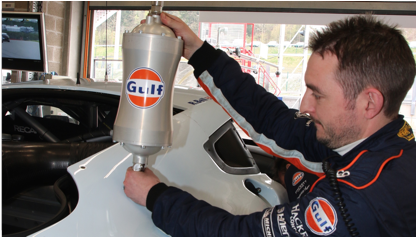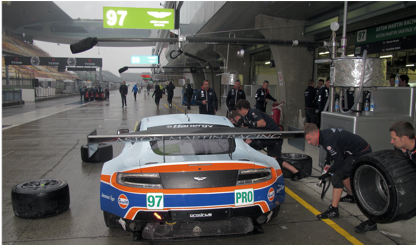Pit Strategy: A crucial difference for Gulf and AMR in China?
02 Nov 2015
|
Shanghai International Circuit |
  |

The Shanghai International Circuit, China is the venue, this weekend, for the penultimate round of the 2015 World Endurance Championship (WEC).
The Gulf lubricated Aston Martin Racing (AMR) Vantage GTEs have been shipped from Japan, where the team once again featured on the podium in GTE Am - with the #98 car - and four are due to take the start of 6 Hours of Shanghai on Sunday at 11.00am local time.
One of the strengths of the WEC has been its ability to create extremely close racing. Often races are decided by mere seconds, even at the end of six hours of racing and so any advantage gained during the course of the race, can create a margin small enough to be the difference between winning and a place that is off the podium.
For that reason the teams focus very heavily on their pit stop strategy. Gulf’s motorsport partners Aston Martin Racing put a great deal of thought – and a lot of practice – into how they plan and execute their time in the pits during the race, as AMR’s Senior Analysis Engineer, Alistair Grimshaw explains:
“Our basic plan for all of the six hour races is the same, but we use the Free Practice sessions at each race to determine both fuel consumption and tyre performance for that specific race. For instance, a tank of fuel will usually last around an hour, but at some circuits – Fuji for instance – and in some conditions, the fuel might last an extra five or ten minutes, which gives us more flexibility in planning our stops.
The WEC regulations say that only two people can work on a car at any one time in the pit lane. A fuel stop takes about 25-30 seconds and a tyre stop about 20 seconds – so if tyres don’t have to be changed, they won’t be. It is a trade off in time spent changing tyres and time lost on the track by running tyres that might not be at their best.
“We are only allowed six sets of tyres for the race, and obviously we try to be as economical with these as possible. During Free Practice we can determine how the tyres perform and last. During an hour stint the tyre performance might deteriorate and necessitate a change – even if there is still enough rubber on the tyre to last for another stint, or, at another circuit the performance might still be good at the end of an hour, but there isn’t enough rubber to last for another stint - so again, we would change tyres.” |

AMR also developed now-famous “oil bomb,” which delivers two litres of pre-heated Gulf engine oil, under pressure into the engine in less than three seconds, as another weapon for saving time at pit stops.
Under normal race conditions, therefore, the team will stick to its pre-determined pit stop plan. However, that can all change if there is a safety car period or, as is more often the case, a Full Course Yellow period, where the cars operate under a ‘virtual safety car’, maintaining their position on the track, but with their speed limited to 80kph.
“Under a safety car, or a Full Course Yellow, a well timed pit stop can make a huge difference to the outcome of the race,” continues Alistair Grimshaw. “We do lots of calculations on pit stops around these situations at various stages in the race – usually working back from the end of the race, to see their possible effects.
“Usually we stagger our pit stops to avoid pit congestion and losing a few seconds having to shuffle cars around others already parked in mid-pitstop as the pitlane is so tight. But taking advantage of a pitstop under these circumstances can make such a difference, that we’re willing to take the hit. Of course, we have to be really alert when these situations develop to be able to call the cars in at the optimum time.”
Pit stop practice has become a regular part of both the race weekend and the build up to a race. “We spend an hour per car two or three times a week at the factory and then half an hour per car per day at the race track” – as illustrated by the accompanying image. The driver line-up for the 6 Hours of Shanghai is as follows:
GTE Pro #97 – Darren Turner, Johnny Adam #99 – Richie Stanaway, Alex MacDowall, Fernando Rees
GTE Am #96 – Francesco Castellacci, Liam Griffin, Stuart Hall #98 – Paul Dalla Lana, Pedro Lamy, Mathias Lauda
The 6 Hours of Shanghai commences at 11.00 (CET –7 hours) on Sunday November 1st and will be covered live on both Eurosport and Motors TV in its entirety as well as live on the Fox Sport network in the Americas. For further information, please contact Kwok Yew Meng at ym.kwok@gulf-marine.com |



